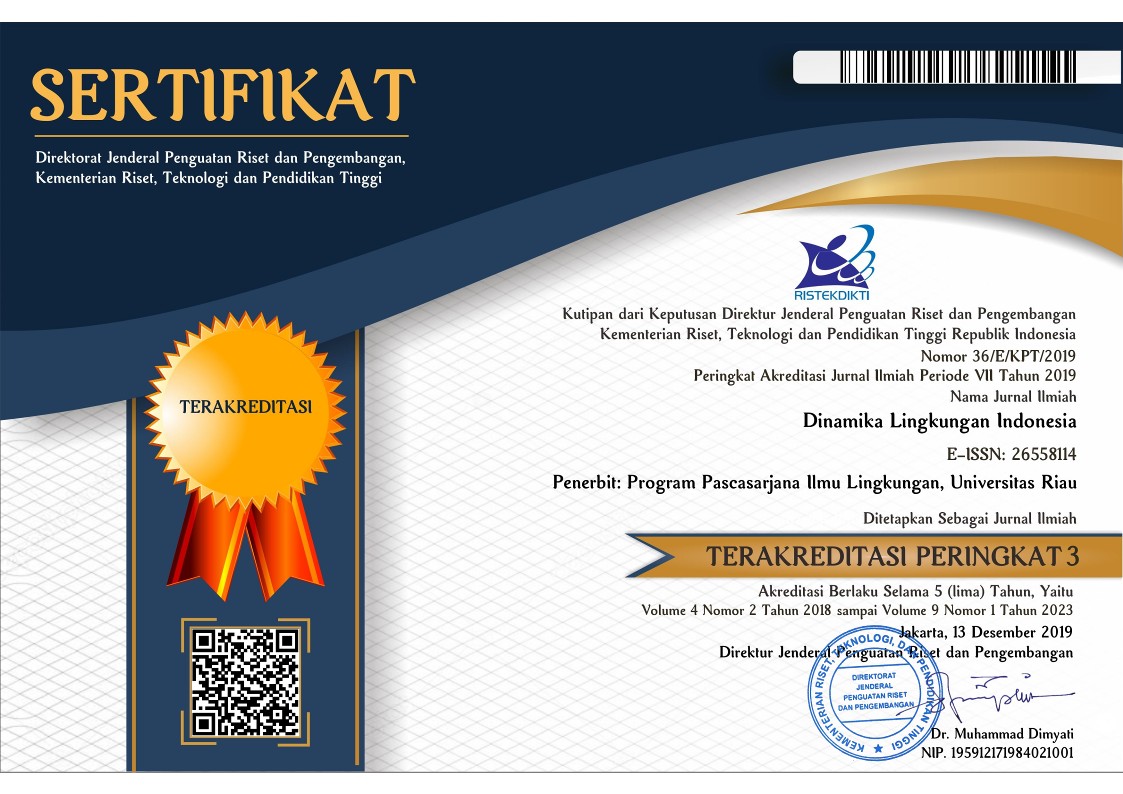Perubahan Sosial dan Relisiensi Nafkah Rumah Tangga Petani Karet di Kecamatan Sentajo Raya Kabupaten Kuantan Singingi Provinsi Riau
Abstract
Farmers often experience vulnerability due to various factors including access difficulties, limited natural resources, marginality, level of technology and education of farmers. This is also the case for Rubber Farmers in Sentajo Raya District and they often experience ecological pressures such as floods. Besides that, social change often has an impact on them. Even though their rubber plantations are flooded every year, they persist with their work. There is no empirical data that can answer the adaptation of society in social change and dealing with flood disasters. The livelihoods of residents in Sentajo Raya District are farmers, especially rubber farmers. SinceSince a few years ago the life of rubber farmers in this area has experienced ups and downs. Rubber farmers in this area are always under ecological pressure and social pressure, such as floods and expansion of oil palm plantations. In continuing their lives, they often experience ecological pressures and social pressures, various forms of resilience are needed to survive. The forms of resilience of the Sentajo District Rubber Farming community have not been known empirically. Therefore, this research is interesting to do. This study aims to analyze the livelihood resilience and the social environment changes of rubber farmer households in Sentajo Raya District, Kuantan Singingi Regency. This research is a survey research with a qualitative approach. Data collection techniques through observation, interviews, and Focus Group Discussion (FGD). Data analysis used descriptive qualitative. The results of this research are expected to be able to identify forms of community adaptation, evaluate social change, analyze the level of welfare and forms of livelihood resilience for the sustainability of their lives.
Keywords
Full Text:
PDFReferences
Adger WN, Kelly P.M, Winkels A, Huy LQ, Locke C. (2002). Migration, remittances, livelihood trajectories, and social resilience. AMBIO: A Journal of the Human Environment. 31 (4):358-366.
Andrianyta H., Hermawan H. (2016). Analisis Perubahan Perilaku Petani Sebagai Adaptasi Terhadap Dampak Perubahan Iklim Di Daerah Iklim Kering Nusa Tenggara Timur. Prosiding Seminar Nasional Agroinovasi Spesifik Lokasi Untuk Ketahanan Pangan Pada Era Masyarakat Ekonomi ASEAN.
Chambers, R. & G. Conway. (1992). Sustainable rural livelihoods: Practical Concepts for The 21st Century. IDS Discussion Paper 296. Brighton: IDS. (pp.7-8). 33.
Dharmawan, A. H., & Nissa, Z. N. A. (2020). Kerentanan Dan Kelentingan Nafkah Rumahtangga Pedesaan: Sebuah Tipologi Yang Ditarik Dari Studi Kasus Petani Dan Nelayan Skala Kecil Di Indonesia. Sodality: Jurnal Sosiologi Pedesaan, 8(1), 1–13. https://doi.org/10.22500/8202028458.
Cote M, Nightingale AJ. (2012). Resilience thinking meets social theory: Situating social change in socio-ecological systems (SES) research. Progress in Human Gheography. 36(4): 475-489.
Dharmawan AH. (2007). Sistem Penghidupan dan Nafkah Pedesaan: Pandangan Sosiologi Nafkah (Livelihood Sociology) Mahzab Barat dan Mahzab Bogor’. Sodality: Jurnal Transdisiplin Sosiologi, Komunikasi dan Ekologi Manusia Vol 01 (02).
Dharmawan, AH. (2001). Farm Household Livelihood Strategies and Soci-economic Changes in Rural Indonesia. [Disertasi]. Germany: the GeorgAugust University of Gottingen.
Ellis, F. (2000). Rural livelihoods and diversity in developing countries.Oxford: Oxford University Press. Faqih A, Rohayati N. (2015). Hubungan Program Lumbun Pangan Sawah Dengan Ketahanan Pangan Keluarga(Kasus di Kelompok Lumbung Pangan Kecamatan Ciwaringin Kabupaten Cirebon). Agrijati. 28 (1):173-187.
Kelly PM, Adger WN. (2000). Theory and practice in assessing vulnerability to climate change and facilitating adaptation. Climate Change.47:325-352. Netherland : Kluwer Academic Publishers.
Longstaff P., N. Armstrong and K. Perrin. (2010). Building Resilient Communities: Tools for Assessment. Homeland Securityaffairs. 6(3):1-23.
Marseva, A. D., Putri, E. I. K., & Ismail, A. (2016). Analisis faktor resiliensi rumah tangga petani dalam menghadapi variabilitas iklim. Jurnal Ekonomi dan Pembangunan Indonesia, 17(1), 15-27.
Maguire, Brigit and S. Cartwright. (2008). Assessing a community’s capacity to manage change: A resilience approach to social assessment. Australia: Bureau of Rural Sciences.
Norris FH, Stevens SP, Pfefferbaum B, Wyche K. (2008). Community Resilience as a Metaphor, Theory, Set of Capabilities, and Strategy for Disaster Readiness.American. Journal of Community Psychology. 41:127-150.
Scoones, I. (2009). Livelihoods perspectives and rural development Livelihoods perspectives and rural development. The Journal of Peasant Studies, 36(1), 171–196. https://doi.org/10.1080/03066150902820503.
Scoones, I., (2015). Sustainable Livelihood and Rural Development. UK: Practical action publishing Ltd.
Scoones, I. (1998). Sustainable Rural Livelihoods: A Framework for Analysis‟, Working Paper 72, Brighton, UK: Institute for Development Studies.
Somorin TO, Kolios AJ, Parker A. (2020). Faecal-wood biomass co-combustion and ash composition analysis. Fuel 203: 781-791.
Sujakhu, N. M., Ranjitkar, S., Niraula, R. R., Salim, M. A., Nizami, A., Vogt, D. S., & XuTo, J.(2018). Determinants of livelihood vulnerability in farmingcommunities in two sites in the Asian Highlands. Water International. VOL. 43, NO. 2, 165–182. https://doi.org/10.1080/02508060.2017.1416445.
Syukur M. (2016). Adaptasi Sosial Petani Tadah Hujan Terhadap Perubahan Iklim (Studl Kasus pada Petani Tadah Hujan di kecamatan Sibulue, Kabupaten, Bone). Predestinasi. 9(2): 100-114.
Tang Q, Bennett SJ, Xu Y, Li Y. (2013). Agricultural practices andsustainable livelihoods: rural transformation within the LoessPlateau, China. Appl Geo 41:15–23.
Wichern, J., Descheemaeker, K., Giller, K.E., Ebanyat, P., Taulya, G., van Wijk, M.T., (2019). Vulnerability and adaptation options to climate change for rural livelihoods–A country-wide analysis for Uganda. Agricultural Systems 176.
DOI: http://dx.doi.org/10.31258/dli.11.1.p.33-42
Refbacks
- There are currently no refbacks.

This work is licensed under a Creative Commons Attribution 4.0 International License.





